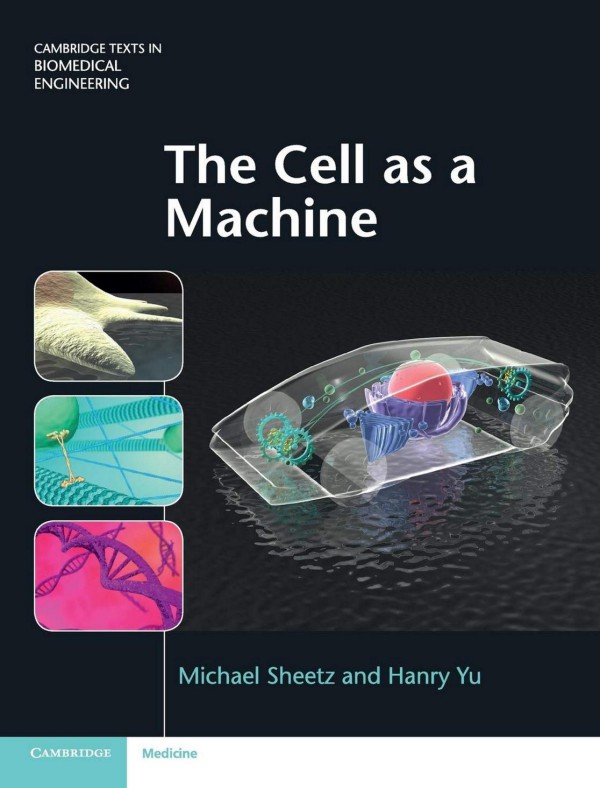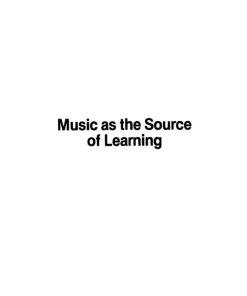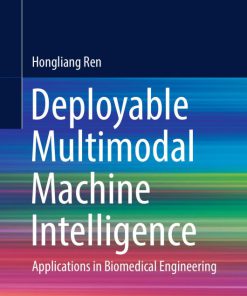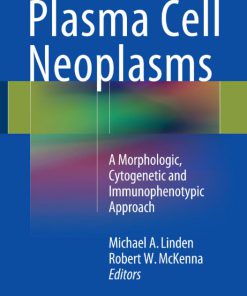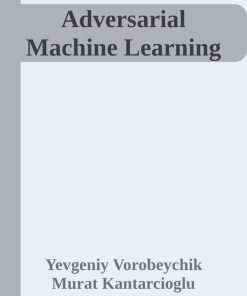(Ebook PDF) The Cell as a Machine 1st edition by Michael Sheetz, Hanry Yu 1108546919 9781108546911 full chapters
$50.00 Original price was: $50.00.$25.00Current price is: $25.00.
Authors:Michael Sheetz, Hanry Yu , Series:Biomedical [49] , Author sort:Michael Sheetz, Hanry Yu , Languages:Languages:eng , Published:Published:Mar 2020 , Publisher:CAMBRIDGE UNIVERSITY PRESS
The Cell as a Machine 1st edition by Michael Sheetz, Hanry Yu – Ebook PDF Instant Download/DeliveryISBN: 1108546919, 9781108546911
Full download The Cell as a Machine 1st edition after payment.
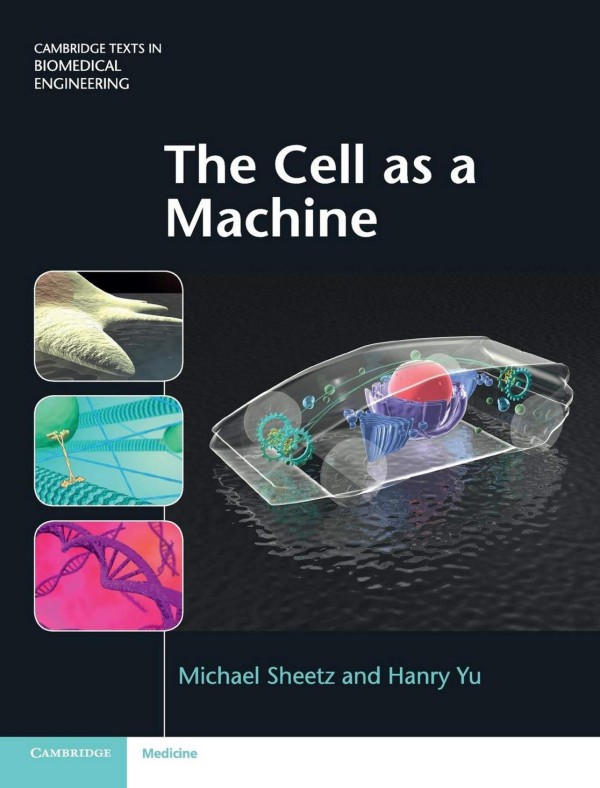
Product details:
ISBN-10 : 1108546919
ISBN-13 : 9781108546911
Author : Michael Sheetz, Hanry Yu
This unique introductory text explains cell functions using the engineering principles of robust devices. Adopting a process-based approach to understanding cell and tissue biology, it describes the molecular and mechanical features that enable the cell to be robust in operating its various components, and explores the ways in which molecular modules respond to environmental signals to execute complex functions. The design and operation of a variety of complex functions are covered, including engineering lipid bilayers to provide fluid boundaries and mechanical controls, adjusting cell shape and forces with dynamic filament networks, and DNA packaging for information retrieval and propagation. Numerous problems, case studies and application examples help readers connect theory with practice, and solutions for instructors and videos of lectures accompany the book online. Assuming only basic mathematical knowledge, this is an invaluable resource for graduate and senior undergraduate students taking single-semester courses in cell mechanics, biophysics and cell biology.
The Cell as a Machine 1st Table of contents:
Part I Principles of Complex Functions in Robust Machines
1 Robust Self-replicating Machines Shaped by Evolution
1.1 The Cell is a Self-contained and Self-replicating Machine
1.2 Cell Functions have Evolved According to Darwinian Selection
1.3 Robustness is Strongly Favored in the Evolution of Cell Functions
1.3.1 Number of Proteins per Cell
1.3.2 Salinity and pH
1.3.3 Temperature
1.3.4 Nutrient Level
1.3.5 Other Environmental Factors
1.4 The Cell State and its Environment have an Effect on Cellular Functions
1.5 Eukaryotic Cells are Organized into Compartments
1.6 Coordination of Functions Can Yield Emergent Properties
1.7 Summary
1.8 Problems
1.9 References
1.10 Further Reading
2 Complex Functions of Robust Machines with Emergent Properties
2.1 Principles of Robust Machines with Standard Functions
2.2 Compartmentalization of Complex Functions (Localized and Modular)
2.2.1 Nucleus
2.2.2 Endoplasmic Reticulum
2.2.3 Golgi Apparatus
2.2.4 Mitochondria
2.2.5 Endosomes
2.2.6 Lysosomes
2.2.7 Peroxisomes
2.2.8 Non-membranous Compartments
2.2.8.1 Implications of Compartments for Modeling of Complex Functions
2.3 Compartments Communicate to Coordinate Functions for Emergent Properties
2.4 Complex Functions Should Not Be Overly Complex
2.5 Complex Functions are Largely Digital (On/Off) and Automatically Turn Off (Term Limits)
2.6 Term Limits (Complex Functions Automatically Turn Off)
2.7 Complex Functions are Cyclic in Nature
2.8 Backups or Variations of Important Complex Functions
2.9 Summary
2.10 Problems
2.11 References
2.12 Further Reading
3 Integrated Complex Functions with Dynamic Feedback
3.1 How to Approach a Complex Function
3.2 Steps in a Complex Function
3.3 Decision-making in Complex Functions
3.4 Integrated Complex Functions
3.4.1 Non-linear Complex Functions in Robust Integrated Systems
3.5 Summary
3.6 Problems
3.7 References
4 Cells Exhibit Multiple States, Each with Different Functions
4.1 The Role of Cell State or Phase in Cell Functions
4.2 Cell Phase versus Linked Complex Functions
4.3 Cell Phases in Cultured Cells
4.4 Protein Composition and Phase Behaviors
4.5 Analysis of Functions and Cell Phases
4.6 Definition of Cell Cycle Phases
4.6.1 Analysis of Mitosis
4.7 How Do Cells Make Important Decisions to Change Phases?
4.8 What Does a Cell Need to Know About the Matrix for Growth?
4.9 Detailed Consideration of Suspension Phase and Transition to Spreading
4.10 Two Different Modes of Spreading Constitute Two Different Phases
4.11 Contractile Spreading Enables the Cell to Sense Substrate Rigidity
4.11.1 Force and Adhesion Maturation
4.12 Regional Specialization in Cells Can Involve Phase Changes
4.13 Many Integrated Complex Cell Functions Involve Multiple Cell Phases
4.14 Summary
4.15 Problems
4.16 References
4.17 Further Reading
5 Life at Low Reynolds Number and the Mesoscale Leads to Stochastic Phenomena
5.1 Thermal Energy versus Momentum at Low Reynolds Number
5.1.1 Viscous Drag on Particles
5.1.2 Diffusion of Small Particles
5.1.2.1 Important Features of Diffusion
5.1.3 Root-mean-square displacement 1/2
5.1.3.1 Gaussian Distribution of Diffusing Particles
5.1.3.2 Diffusive Transport
5.1.4 Practical Implications of the Diffusion Equation
5.2 Diffusion in Cells
5.2.1 Ion and Metabolite Diffusion
5.2.2 Protein Diffusion
5.2.3 Membrane Diffusion
5.2.4 Diffusion of Cytoskeletal Proteins
5.2.4.1 Non-ideal Diffusive Processes
5.2.4.2 Diffusion within a Corral
5.3 Diffusional Transport and Active Transport
5.3.1 Active Transport
5.3.2 Constraints of Diffusion
5.4 Summary
5.5 Problems
5.6 References
5.7 Further Reading
Part II Design and Operation of Complex Functions
6 Engineering Lipid Bilayers to Provide Fluid Boundaries and Mechanical Controls
6.1 Membranes as Compartment Boundaries
6.2 Chemical Order of Membranes
6.3 Lipid Composition
6.4 Linking Proteins to Membranes
6.5 Lipid Organization – Matching of Surface Areas, Phases, Charges
6.6 Fusion and Fission
6.7 Lipid Asymmetry and the Bilayer Couple
6.7.1 Transport across Membranes
6.8 Physical Reality of Membranes
6.8.1 (a) Membranes are Inelastic
6.8.2 (b) Membranes are Fluid (Diffusion and Flow)
6.9 Plasma Membrane Protein Diffusion is Controlled by Cytoskeletal Corrals
6.10 Membrane Exchange Rates are Sufficient to Produce Lateral Inhomogeneities
6.11 Membrane Curvature and Protein or Metabolite Concentration
6.12 Concentration at Membrane Surfaces Enables More Dynamic Interactions
6.13 Lipid Asymmetry and Charge Effects
6.14 Inositol Lipids and Changes in Level of Charge
6.15 Flippases and the Loss of Asymmetry
6.16 Summary
6.17 Problems
6.18 References
6.19 Further Reading
7 Membrane Trafficking: Flow and Barriers Create Asymmetries
7.1 Secretory Pathway
7.2 Fission–Fusion Mechanisms
7.3 Coatamers in Vesicular Exocytic Pathway
7.4 Golgi Processing Involves a Series of Steps with Ordered Enzymes
7.5 Endocytosis is Designed to Send Back Good and Degrade Bad Proteins
7.6 Sorting Mechanisms
7.7 Physical versus Biochemical Sorting
7.8 Summary
7.9 Problems
7.10 References
7.11 Further Reading
8 Signaling and Cell Volume Control through Ion Transport and Volume Regulators
8.1 Intracellular and Extracellular Ionic Environments Differ
8.2 Transmembrane Gradients Store Useful Energy
8.3 Ion Transport by Membrane Transport Proteins
8.3.1 Permeability through Membrane Pores
8.3.2 Membrane Transport Proteins (Na+/K+ Pump, Ca2+ Pump and Na+, H+ Pump)
8.4 Electrochemical Gradients
8.5 Ion Channels Fluctuate between Closed and Open Confirmations
8.6 Equilibrium Potentials and Action Potentials
8.7 Important Aspects of Depolarization Waves
8.8 Muscle Cells Propagate Depolarization Waves
8.8.1 Broader Implications of Depolarization Waves
8.9 Calcium Signals can be Different
8.10 Resting Membrane Potential Formation and Relevant Diseases
8.11 Mechanosensitive (MS) Ion Channels Initiate Cell Volume Regulatory Responses
8.12 Cell Volume Control over Longer Timescale or in Tissue Repair via Cellular Hypertrophy
8.13 Summary
8.14 Problems
8.15 References
8.16 Further Reading
9 Structuring a Cell by Cytoskeletal Filaments
9.1 The Case for a Dynamic Cytoskeleton
9.2 What Are Major Cytoskeleton Functions?
9.3 Polymerization in Cellular Systems
9.4 Monomeric Filaments
9.5 Dimeric Filaments
9.6 Multimeric Filaments
9.7 The Consequences of Filament Polarity
9.8 Energetics of Polymerization and Depolymerization
9.9 Microtubule Dynamics (Nucleotide Hydrolysis, Polarity, Treadmilling, and Dynamic Instability)
9.10 Microtubules as Cytoplasmic Organizers
9.11 Cilia (Primary Cilia) and Flagella
9.12 Intermediate Filaments
9.13 Filament Mechanics
9.14 Persistence Length
9.15 Freely Jointed Chain
9.16 Consequences for Cellular Mechanics
9.17 Molecular Mechanics
9.18 Organization of the Cytoskeleton
9.18.1 Formin-dependent Actin Polymerization
9.18.2 ENA/VASP and WAVE
9.18.3 Arp2/3 Branching
9.18.4 Actin Filament Disassembly
9.18.5 Actin Filament Crosslinking
9.19 Microtubule Dynamics
9.19.1 Mitosis and Cytokinesis as Cytoskeletal Functions
9.20 Summary
9.21 Problems
9.22 References
9.23 Further Reading
10 Moving and Maintaining Functional Assemblies with Motors
10.1 Defining Linear Motor Systems
10.2 How do Motors Move?
10.3 AAA Family of ATPases
10.4 Energetics of Motor Movement
10.5 Motor Types
10.6 Processive vs. Non-processive Myosin
10.6.1 Non-muscle Contraction Systems
10.7 Kinesin
10.8 Dynein
10.9 Why Is There So Much Microtubule Motor Traffic in Cells?
10.10 Summary
10.11 Problems
10.12 Reference
10.13 Further Reading
11 Microenvironment Controls Life, Death, and Regeneration
11.1 Microenvironment in Regeneration
11.2 Cell–ECM Receptors and Mechanics
11.3 Clustering and Geometry
11.4 Matrix Adhesion Signaling
11.5 Rigidity
11.6 Matrix Configurations in Tissues
11.7 Fibrous Matrices
11.8 Basement Membranes
11.9 Cell Encompassing Matrices
11.9.1 3D versus 2D
11.10 Tissue Formation through Cell–Cell Adhesions
11.10.1 Conveying Mechanical Information between Cells
11.11 Cell–Cell Adhesions
11.12 Processing by Adhesions
11.13 The Role of Cell–Cell Adhesions in Cell Death
11.14 Junction Migration
11.15 Epithelial Wound-healing
11.16 Summary
11.17 Problems
11.18 References
11.19 Further Reading
12 Adjusting Cell Shape and Forces with Dynamic Filament Networks
12.1 Motility Processes in Isolated Cells
12.2 Matrix Shape can Control Cell Behavior
12.3 Cell Migration Mechanisms
12.3.1 Mesenchymal Cell Migration
12.4 Lamellipodial Extensions
12.5 Filopodial Extensions
12.6 Amoeboid Extensions
12.7 Sarcomere Contraction Units
12.8 Podosomes and Invadopodia
12.9 Cohesive Network Assembly and Dynamics
12.10 Adhesion Site Assembly and Dynamics
12.11 Endoplasmic Cages Confer Coherence at the Cell Periphery
12.11.1 Coupling of Growth Cone Motility with Microtubule Movements
12.12 Modeling of Actin-based Motility
12.13 Multicellular Movements as Coordinated Motile Processes in Tissue Formation
12.14 Maintaining Shape through Adhesions and Volume
12.15 Cohesive Cytoplasmic and Cellular Networks
12.16 Migration of Cell Monolayers
12.17 Endothelial Cells and Tensegrity
12.18 Curving or Reshaping Epithelia in Development
12.19 Summary
12.20 Problems
12.21 References
12.22 Further Reading
13 DNA Packaging for Information Retrieval and Propagation
13.1 Much More DNA than in Genes
13.2 Retaining Accessibility of Condensed DNA
13.3 DNA Accessibility in Specific Cell Types
13.4 Nuclear Envelope
13.5 Nuclear Pore Complexes
13.6 Nucleolus
13.7 Nucleosome Condensation and Organization
13.8 Euchromatin and Heterochromatin
13.9 Chromosome Territory Organization
13.10 Organization of Transcription Factories in between Chromosomes
13.11 Nuclear Envelope and Chromatin Organization
13.12 Replication
13.13 Mitosis
13.14 Reversal of Differentiation
13.15 Summary
13.16 Problems
13.17 References
13.18 Further Reading
14 Transcribing the Right Information and Packaging for Delivery
14.1 RNA Transcription Factors (Specificity Two Sites per Nucleus or 30 Picomolar)
14.2 Timescales and Transcription Factors
14.3 Signal Transduction from the Periphery to the Nucleus
14.4 Differentiation and Expression Patterns
14.5 Transcription Machinery
14.6 Transcription Factories in the Nucleus
14.7 Processing of mRNA for Export
14.8 Quality Control of mRNA
14.9 Movement Out of the Nucleus
14.10 Micro-RNAs Can Decrease the Lifetime of mRNAs
14.11 Summary
14.12 Problems
14.13 References
14.14 Further Reading
15 Turning RNA into Functional Proteins and Removing Unwanted Proteins
15.1 The Complex Function of Protein Synthesis
15.2 Translation by Ribosomes
15.3 Initiation of Translation
15.4 tRNA Loading with an Amino Acid
15.5 Elongation of the Polypeptide
15.6 Termination and Ribosome Recycling
15.7 Protein Translation Occurs at Specific Sites
15.8 Movement of mRNA in Cytoplasm (Specific Localization)
15.9 Quality Control of Protein being Synthesized (Chaperones)
15.10 Signal Sequences and Translation into the ER
15.11 Control of Translation by Protein Concentration
15.12 Protein Degradation
15.13 Autophagy and Abnormal Protein Turnover
15.14 Stimulated Degradation of Proteins by Ubiquitin Ligation
15.15 Rationale for Overall Protein Levels
15.16 Dynamic versus Stable
15.17 Starvation, Feasting, and Senescence
15.18 Summary
15.19 Problems
15.20 References
15.21 Further Reading
Part III Coordination of Complex Functions
16 How to Approach a Coordinated Function: Cell Rigidity-sensing and Force Generation across Length Scales
16.1 A Systematic Approach
16.2 Description of Initial State
16.3 The Process of Cell Spreading on Fibronectin
16.4 Initial Matrix Binding and Activation of Spreading
16.5 Spreading is Dependent on Fibronectin Concentration
16.6 Rapid Spreading of the Cells Following Force-dependent Activation
16.7 Membrane Tension-driven Activation of Contraction
16.8 Periodic Contractions and Rigidity-sensing
16.9 Rigidity-sensing by Local Contractions of Sarcomere-like Units
16.10 Enzyme Pathways in Rigidity-sensing
16.11 Stabilization and Maturation of Adhesions by Force
16.12 Sensing by Actin Flow
16.13 Analysis of Other Complex Functions
16.14 Summary
16.15 Problem
16.15.1 Paper and Discussion of Anonymous Hypotheses
16.15.2 Hypothesis
16.15.3 Sample Paper for Student-Generated Hypothesis
16.16 References
16.17 Further Reading
17 Integration of Cellular Functions for Decision Making
17.1 Quantitative Analyses and Modeling
17.2 Modeling in a Cellular Context
17.3 Timescale and Integration
17.4 Modeling Based on Composition vs. Environment
17.5 Control of the Cell Cycle and Checkpoints
17.6 Integration in Cell Growth
17.7 Coordination of Multiple Functions
17.7.1 Epithelial Wound-healing and Cell Proliferation
17.8 Linkage to Protein Content
17.9 Summary
17.10 Problem
17.11 References
17.12 Further Reading
18 Moving from Omnipotency to Death
18.1 Objectives of Development
18.2 Cell Differentiation
18.3 Early Development
18.4 Formation of the Three Tissue Layers
18.5 Heart Development
18.6 Pattern Formation
18.7 Size and Shape Matters
18.8 Manifestation of Differentiation State in Nuclear State
18.9 Commitment in Differentiation
18.10 Structured Nuclei in Differentiated Cells with Limited Expression
18.11 Mechanical Aspects of Nuclear Organization in Development
18.12 Chemical Changes with Differentiation
18.13 Repair Involves Dedifferentiation
18.14 Aging as a Part of Development
18.15 Summary
18.16 Problem
18.17 References
18.18 Further Reading
19 Cancer versus Regeneration: The Wrong versus Right Response to the Microenvironment
19.1 Benign vs. Cancerous Tumors
19.2 Rigidity-independent Growth from the Loss of Mechanosensory Modules
19.3 Depletion of Mechanosensory Machines is not Reversible by Drugs
19.4 Many Different Mutations can cause Module Loss and Uncontrolled Growth
19.5 Growth States after the Loss of Control Modules
19.6 Repair Mechanisms and Trauma can Stimulate Metastatic Growth
19.7 Fibrosis in Aging and Regeneration can cause Growth
19.8 Which Mutations Drive Metastatic Cancers?
19.9 Sustaining Proliferation by RTKs
19.10 Downstream Signaling Pathways Involved in Growth
19.11 Steps that Could Inhibit Further Growth
19.12 Evading Growth Suppressors
19.13 Resisting Cell Death by Apoptotic Mechanisms
19.14 Enabling Replicative Immortality
19.15 Inducing Angiogenesis
19.16 Competition for Space in Confined Organs
19.17 Metastasis and Migration
19.18 Therapies
19.19 Summary
19.20 Problem
19.21 References
19.22 Further Reading
People also search for The Cell as a Machine 1st:
is the cell really a machine
what is cell machinery
what is cellular machinery
the cell as a car
the cell as a factory

